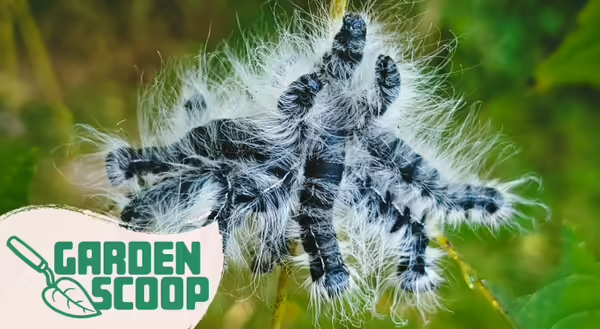
A few weeks ago, I was exploring a woodland near Springfield and ran across a fuzzy cluster of feeding insects. It was slightly out of reach, congregated in a lower limb of a young black walnut tree (Juglans nigra).
While grabbing a nearby stick and attempting to pull the limb down and get a closer look, I noticed the wiggling, writhing clump was a group of feeding caterpillars. My first thought was that they may be fall webworms (Hyphantria cunea), but there was no sign of the telltale web these communal caterpillars are known for. However, fall webworm feeds on a variety of species, and walnut is certainly one that I’ve noticed them on over the years.
As I bent the limb further downward to get a better look, the mass of caterpillars seemed to come alive in reaction to the disturbance. All the caterpillars in the group began writhing about, pointing upward with their heads and tails as if they were fighting off some invisible predator.
Upon closer inspection, the caterpillars in question were certainly larger than fall webworms with different characteristics. These caterpillars were dark black with contrasting, spikey white hairs sticking out in all directions.
After some quick research, I concluded that this insect must be the aptly named walnut caterpillar (Datana integerrima). Its black body with frizzy, wiry white hair was a giveaway once I realized I was looking at mature caterpillars. These caterpillars emerge as tiny green larvae, turning a pretty reddish-brown with longitudinal strips underneath as they get larger and finally winding up black and fuzzy at maturity. In the past, I had only observed the younger life stages, so it was a real treat to see these larger, more distinctive caterpillars.
Although walnut is the preferred host, this native insect does feed on other species such as pecan, hickory, and other native tree species. Like many other caterpillars, they feed together in one large cluster that goes limb to limb. Feeding is confined to leaves, and they do not consume the larger veins, leaving behind a skeleton of the leaf as they gregariously eat all foliage in their path.
When disturbed while feeding, they are known to react by arching their head and tail. Their odd movement makes the insect appear in pain or battle with some invisible foe. This is meant to be a defense mechanism, and when you see an entire cluster of caterpillars doing this, it's certainly something that makes me step back.
However, their main defense mechanism is simply strength in numbers. Walnut caterpillars are attacked by a number of both invertebrate and vertebrate predators who typically keep their numbers in check from year to year. Since they feed in a big cluster, the hope is that one predator will not get all of them, leaving some behind to overwinter. Like many insects, their number each year may be cyclical and impacted by the local predator population or the cycles of their host plant.
In the absence of a protective web, like with fall webworm, these caterpillars seem like easy prey, and a good number of them typically get eaten before they can reach adulthood. Since a single adult can lay 300-500 eggs, their strength is the great number of larvae produced that, hopefully, can overwhelm predators, allowing some to reach maturity.
On the other hand, these caterpillars and the many others that inhabit tree canopies are an incredibly important food source for birds or other predators. In an ecological sense, most of these caterpillars were born to be eaten, and it's important that we preserve their populations as a food source and their role as native pollinators.
As the surviving walnut caterpillars reach full size in September, they tend to move downward on the tree and congregate for one last molting before dropping to the soil to overwinter as pupa in the soil. The following spring, typically in May sometime, they will emerge as adults to feed on nectar, pollinate flowers, and lay eggs, so the process can start again.
Generally, walnut caterpillar feeding has little impact on the host plants since they consume leaves so late in the year. The leaves they eat in September have already produced energy all summer, and the loss this late in the season is inconsequential. So, we typically don’t recommend control of this native tree pest. It's best to leave them for the birds!